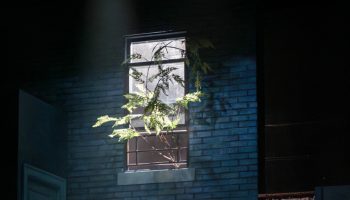
Julia Weber
Staff Writer
Chautauqua Theater Company’s mainstage production Execution of Justice continues its run of performances this weekend at 4 p.m. Saturday and 2 p.m. and 7:30 p.m. Sunday in Bratton Theater.
John Kolbinski, the sound supervisor at CTC, began developing the production months ago. In March, he was already having conversations with sound designer Mark Bennett about how to engineer the sound design for the performances. The engineering process constantly evolves throughout the technical process and often has to respond to practical changes as the play is refined.
Playwright and Director Emily Mann’s Execution of Justice is a work of documentary theater, following the trial of Dan White, the man who assassinated San Francisco Mayor George Moscone and Harvey Milk — a member of the city’s board of supervisors and the first openly gay elected official in the state of California.
For Kolbinski, sound is a crucial component in setting the tone and creating a cohesive atmosphere in the courtroom drama.
“I feel like sound design in this show really elevates the visual, but you’re also still getting a clear visual in the same sense,” Kolbinski said. “Sometimes, the sound will operate completely on its own and generate that visual; here, it’s complementing that visual.”
For Jay Korter, Execution of Justice’s audio engineer, a lot of the work is in creating recurring motifs that drive the plot and character development of the play. While there are certain riffs or other sonic cues of characters, much of the noise is ambient or environmental to drive the tension and pacing of the production.
“You put in a lot of what you call ‘floor raisers’ that add a subtle hum or drone, and then people cut that out, and it sounds so much more quiet than it did before,” Korter said.
“Sometimes your best sound cue is silence,” Kolbinski said. “Giving (the) space to create that silence is actually really powerful.”
Korter’s work is more minute by minute. During the show, he follows along with the script of the play in order to operate microphones accordingly, often mixing the vocal levels in the moment. Any number of circumstantial or atmospheric elements can require changes. Something as simple as rain outside, ambient noise or a voice hoarse from overuse can require in-the-moment alterations to the vocal levels to optimize the sound of the actors.
“(It’s) sort of like playing an instrument along with everybody,” Korter said.
Larkin Ethridge is assistant sound supervisor for Execution of Justice, and she works with actors backstage to problem-solve before and during the production.
“I work most directly with the actors backstage, so my minute to minute is all pre-show,” Ethridge said. “It’s making sure everything is turning on, everything is working, we’re getting signals from everything, but also making sure that I’m helping the actors get the mics put on their bodies in a way that they won’t have to think about it.”
“Because they’re doing two million things on stage without a script in front of them — so many words, so many cues — if I can make sure that they’re not distracted by their mic, I feel like I’ve been able to support them and they need to be able to tell the story,” Ethridge said.
After the rehearsal process, Kolbinski said he has been able to enjoy the production more closely and pick up on moments he missed amid the troubleshooting of gear during their tech rehearsals.
“Watching it on opening (night) felt so different, even though I knew the show really well,” he said. “I started to appreciate something that I may not have tuned into as much in the process because when I was working, making sure everything was functional, everyone was doing well (and) had what they needed, then I sat there and took it in.”




